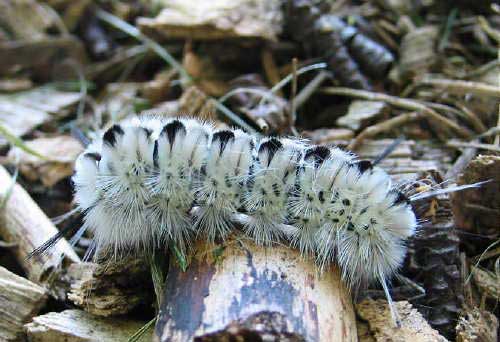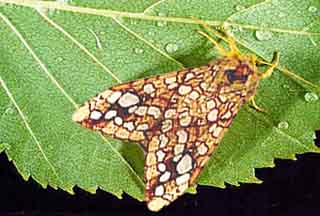The Hickory Tussock Moth:
Lophocampa caryae

Lophocampa caryae, courtesy of Viktoria Serafin, New York state
This site has been created by
Bill Oehlke at oehlkew@islandtelecom.com
Comments, suggestions and/or additional information are welcomed by Bill.
New!
Caring for Woolly Bear CaterpillarsHickory Tussock Moth caterpillars are often found in the fall when their larger size and
bright colouration draw attention. Lophocampa caryae caterpillars are white and black
and are covered in grayish-white hairs. A row of black tufts adorn the first eight
abdominal segments and pairs of long black hair-tufts grace the
first and seventh segments.
Lophocampa caryae caterpillars feed gregariously on the leaves of several hardwoods, but
hickories, walnut and butternut are preferred.
Gray cocoons, spun up in the fall under leaf litter, often incorporate some of the body hairs.
Caryae Tiger Moths emerge from cocoons the following spring, usually in May and June. The underwings are a plain, pale yellow.

Image of Lophocampa caryae moth composited by Bill Oehlke
The Hickory Tussock Moth, (Lophocampa caryae, wingspan 3.0 - 5.5 cm) ranges from Mexico and the
southwestern United States in a diagonal swathe northeastward to Maine and southern portions of
the central and eastern Canadian provinces.
Lophocampa caryae caterpillars have hairs which often trigger alergic reactions on tender skin
and are better left untouched.
One Mom recently wrote: "A word of warning to anyone wanting to
"play" with one. Recently while on Block Island in Rhode Island,
my 3 year old decided to befriend one. Even named him, "Bruce".
Shortly after handling it, his hands became itchy and red and he
seemed to be in pain. He continued to develop a rash all over his
hands, between his fingers and on his belly. We immediately
administered Benydril and within the hour he began to feel better.
However, a day later he still has the rash.
If you have anyone interested in handling these crawlies, you might
warn them that they could have a reaction."
The Hickory tussock moth caterpillars take up to eight weeks to mature and there is a single generation each year
in northern portions of its range, with moths eclosing in the spring.
After nightfall, the female moth extends a scent
gland from the tip of her abdomen.
Night-flying males zigzag in their flights into the wind, pick up the airbourne scent with their
antennae, and locate and mate with the calling female.
Upon separating, the male looks for another mate while the female begins her ovipositing flight
under cover of darkness. Eggs are deposited in large clusters but larvae seldom do any real damage to trees..
Male Lophocampa caryae come in to lights and rest with wings folded over their backs.
If this info has been helpful, please click on the flashing butterfly to express appreciation and to visit other related sites. |
 |
or go to Introduction to WORLD'S LARGEST SATURNIIDAE SITE and click on flashing butterfly there. This site features spectacular photography with the most extensive set of Saturniidae files found anywhere on the internet.
Woolly bear or fuzzy bear caterpillars come in a variety of colours and patterns, many of them
quite striking!
Click on the hypertext (blue print) below to access info and images of various Tiger Moth adults
and caterpillars:
ARCTIIDAE (TIGER MOTH) INDEX:
Larval images are from Caterpillars of Eastern Forests courtesy of David Wagner.
Visit other websites maintained by Bill Oehlke:
Have a nice day!
Go to
Caterpillar Identification








